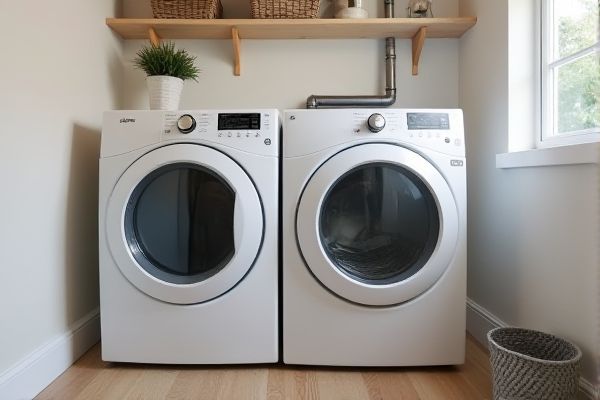
Standard dryer vents expel hot, moist air outside through ductwork, ensuring efficient drying but requiring exterior wall access and regular maintenance to prevent lint buildup. Ventless dryers recycle and condense moisture, offering flexible placement and easier installation, making them ideal for small spaces; explore the rest of the article to determine which option suits your home and lifestyle best.
Table of Comparison
| Feature | Standard Dryer Vent | Ventless Dryer |
|---|---|---|
| Drying Method | Expels moist air through external vent | Condenses moisture inside, no external vent needed |
| Installation | Requires wall or window vent | Flexible, no vent installation required |
| Energy Efficiency | Moderate energy use | Higher energy consumption due to condensation process |
| Space Requirement | Needs vent space outside | Compact, ideal for small spaces |
| Maintenance | Needs regular vent cleaning to prevent lint buildup | Requires periodic water reservoir emptying and filter cleaning |
| Air Quality | Vents moist air outside, preventing indoor humidity | Releases warm air indoors, increasing room humidity |
| Installation Cost | Higher if new vent is needed | Lower due to no vent installation |
| Dry Time | Generally faster drying times | Typically longer drying cycles |
Introduction to Dryer Ventilation Systems
Standard dryer vents expel moist air outside your home through ductwork, preventing humidity buildup and reducing the risk of mold and mildew. Ventless dryers use a heat exchange system to condense moisture and collect it in a reservoir or drain, making them ideal for spaces lacking external vent access. Choosing the right ventilation system impacts your dryer's efficiency, energy consumption, and indoor air quality.
What is a Standard Dryer Vent?
A standard dryer vent is a duct system designed to expel hot, moist air from your dryer to the outside of your home, preventing excess humidity and lint buildup indoors. This vent typically consists of rigid or flexible metal tubing that connects your dryer to an external wall or roof vent, ensuring efficient moisture removal. Choosing a standard dryer vent improves drying performance and reduces the risk of mold growth and fire hazards associated with trapped lint and moisture.
What is a Ventless Dryer?
A ventless dryer, also known as a condenser or heat pump dryer, removes moisture from clothes by condensing water vapor into a collection tray or draining it away, eliminating the need for an external vent. Unlike standard dryer vents that expel hot, moist air outside, ventless dryers recycle heat and moisture internally, saving energy and allowing installation in spaces without an exhaust duct. This design makes ventless dryers ideal for apartments, small homes, or locations where traditional venting is impractical.
Key Differences: Standard vs Ventless Dryers
Standard dryer vents expel hot, moist air outside through ductwork, improving drying efficiency and reducing indoor humidity, whereas ventless dryers use condensation technology to remove moisture internally without external vents, making them ideal for homes without duct access. Standard dryers typically dry clothes faster and handle larger loads but require proper vent installation and maintenance to prevent lint buildup and potential fire hazards. Ventless dryers offer flexible placement and energy-saving benefits but may have longer drying times and require regular water reservoir emptying or drainage.
Installation Requirements and Flexibility
Standard dryer vents require external ductwork that must be installed through an exterior wall, limiting placement options to areas near windows or vents and often involving professional installation. Ventless dryers use a condensation system to recycle moisture internally, needing only a standard electrical outlet and minimal space, offering greater flexibility for installation in apartments or rooms without exterior walls. The absence of ducting in ventless models reduces installation complexity and allows placement in closets or interior spaces where venting is impossible.
Energy Efficiency Comparison
Standard dryer vents expel hot, moist air outside, which can lead to energy loss as your dryer works harder to maintain temperature. Ventless dryers recycle air by condensing moisture, offering improved energy efficiency and reduced heat loss, making them ideal for tight spaces. Choosing a ventless dryer can lower your energy bills by using less power and retaining more heat during the drying cycle.
Maintenance and Cleaning Considerations
Standard dryer vents require regular cleaning to prevent lint buildup that can cause blockages and reduce efficiency, typically every 6 to 12 months. Ventless dryers collect moisture in a reservoir that needs frequent emptying, and their filters must be cleaned after every few loads to maintain optimal performance. Your choice impacts how often you must perform these maintenance tasks, with ventless models generally demanding more frequent but simpler cleaning routines.
Performance: Drying Time and Effectiveness
Standard dryer vents typically provide faster drying times and higher effectiveness by expelling hot, moist air outside, preventing humidity buildup and ensuring clothes dry thoroughly. Ventless dryers use a condensation or heat pump system to recycle air, which can result in longer drying cycles and slightly less efficient moisture removal. Your choice impacts drying performance, especially in areas without external venting options.
Cost Analysis: Initial and Long-term Expenses
Standard dryer vents typically involve higher initial installation costs due to ductwork and professional setup, but their energy efficiency often results in lower long-term utility bills. Ventless dryers have lower upfront expenses since they don't require external venting, yet they may consume more electricity and need regular maintenance, potentially increasing lifetime costs. Your choice between the two depends on balancing upfront investment against ongoing energy and maintenance expenses.
Choosing the Right Dryer for Your Home
Standard dryer vents use external exhaust to remove moisture, requiring proper duct installation to prevent mold and lint buildup. Ventless dryers rely on condensation or heat exchange technology, offering flexible placement without exterior venting but typically consuming more energy. Selecting the right dryer depends on home layout, ventilation availability, and energy efficiency priorities.
 homyna.com
homyna.com